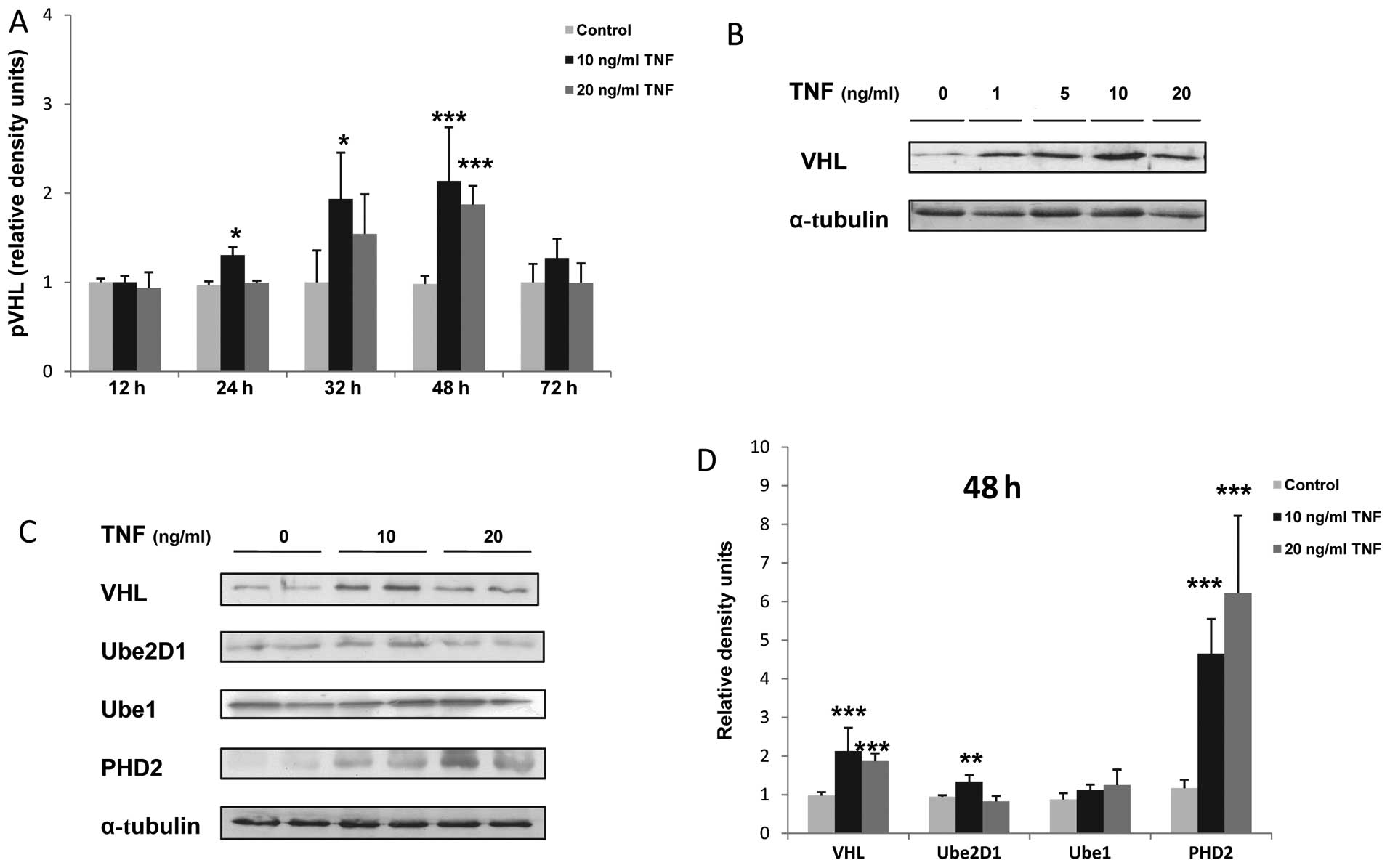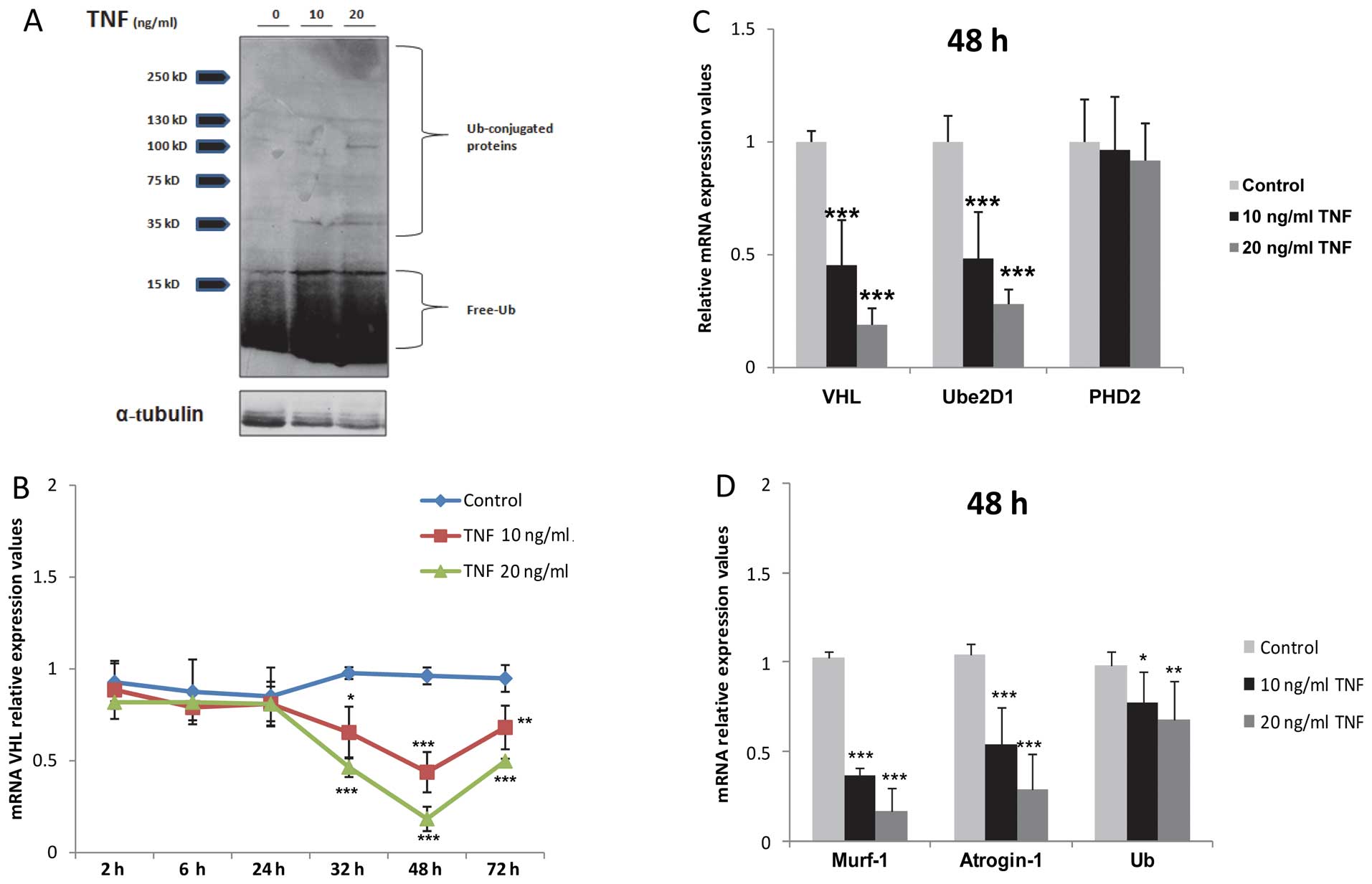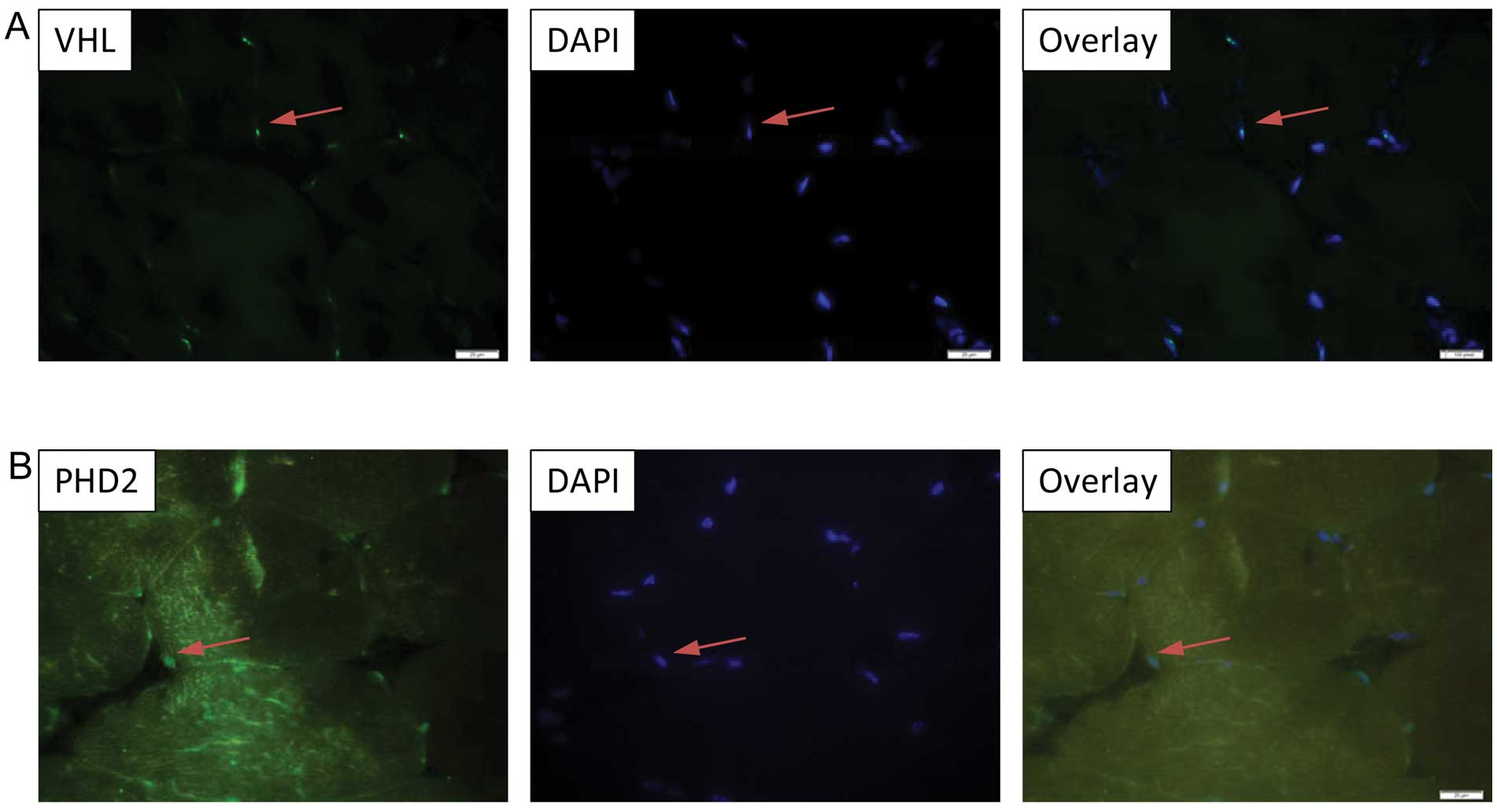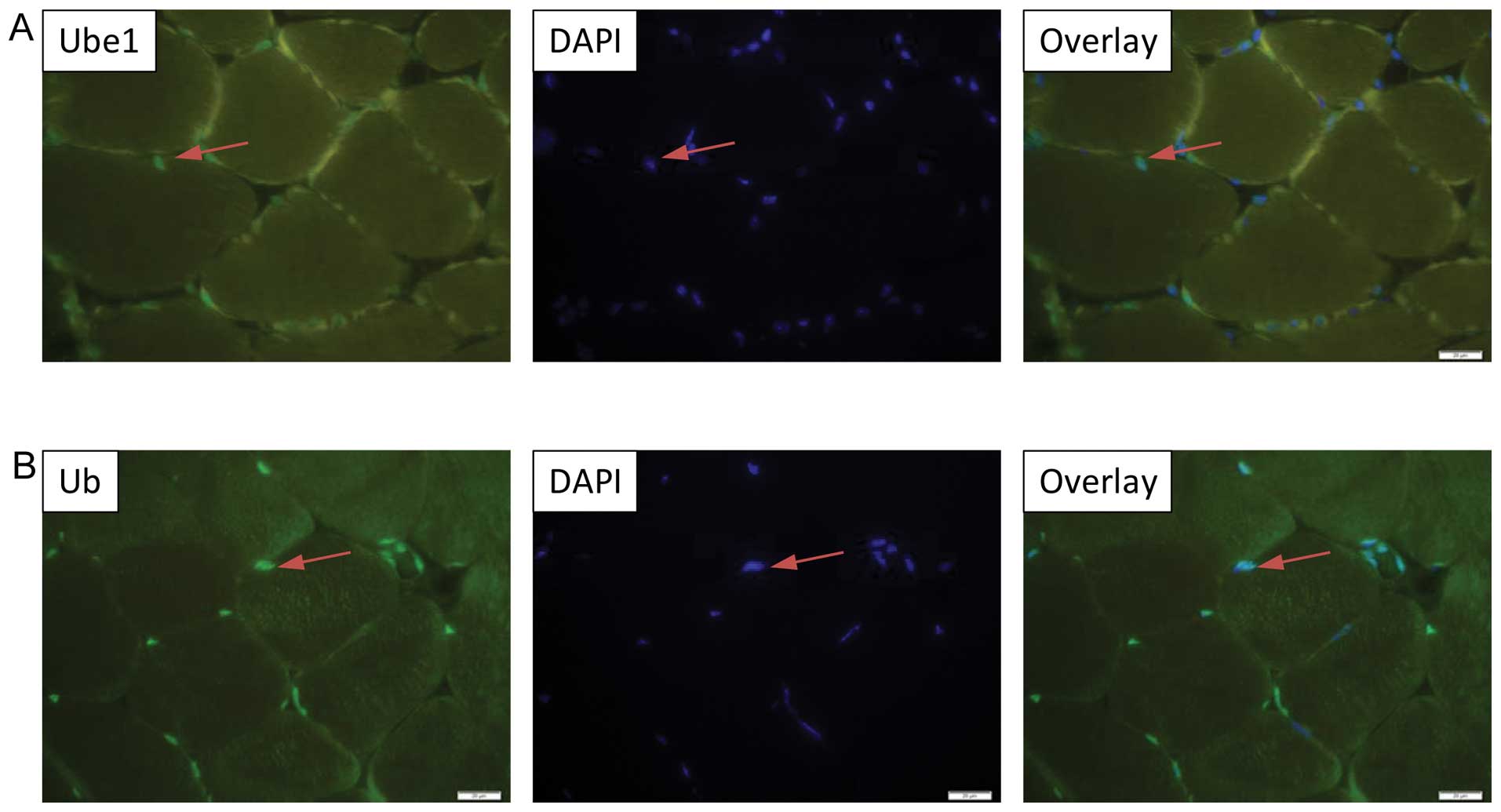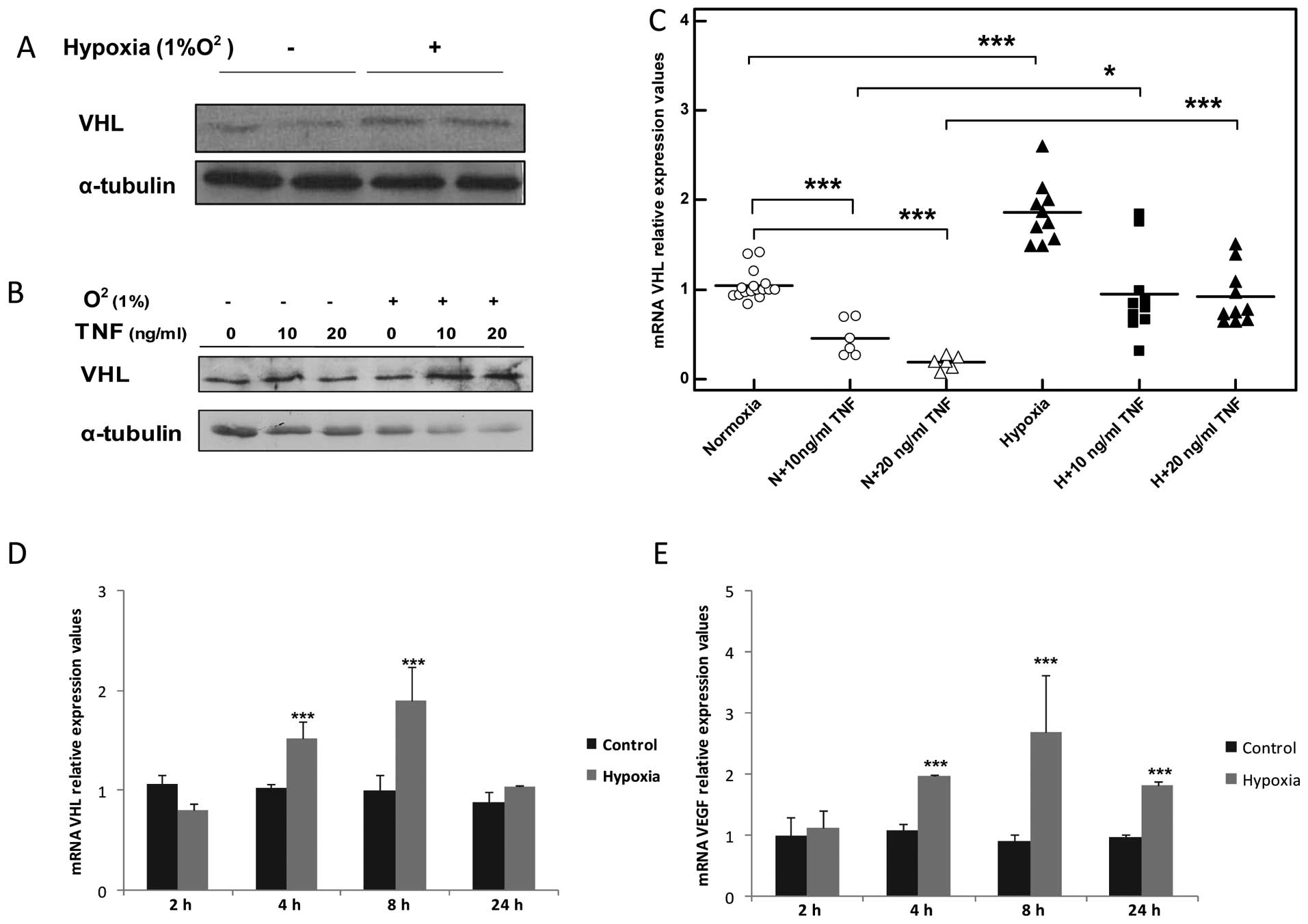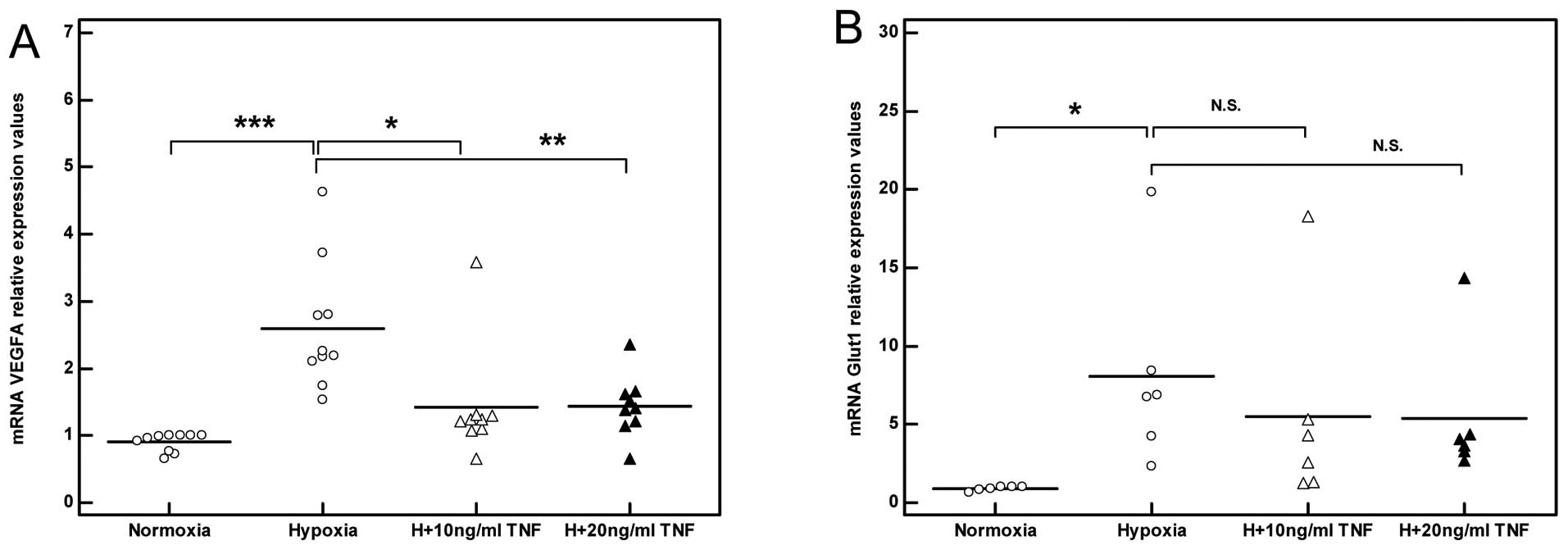TNF stimulation induces VHL overexpression and impairs angiogenic potential in skeletal muscle myocytes
- Authors:
- Published online on: May 9, 2014 https://doi.org/10.3892/ijmm.2014.1776
- Pages: 228-236
Abstract
Introduction
Impaired angiogenic potential and decreased skeletal muscle capillarization are known to contribute significantly to the development of cachexia and progressive muscle wasting in several chronic inflammatory diseases, including chronic obstructive pulmonary disease (COPD) (1–6). The underlying mechanisms mediating decreased skeletal muscle capillarization under these conditions remain poorly understood.
Several inflammatory markers, part of a systemic inflammatory response, have been suggested to be important for the development of cachexia in a number of chronic disorders (7–11) amongst which, elevated serum levels of the pro-inflammatory cytokine, tumor necrosis factor (TNF), have been suggested to be of particular relevance (12). The potential contribution of TNF to the development of cachexia and decreased capillarization in a disease state as COPD remains a matter of debate, due to inconsistency in reports regarding its serum levels in patients with COPD (13–17). However, elevated circulatory TNF levels appear to be associated with muscle loss in patients with confirmed cachexia (16,18), as well as with muscle atrophy and decreased capillarization in animal models of COPD (19–22). Furthermore, TNF is a potent catabolic and anti-angiogenic factor in vitro (23–26).
TNF has been demonstrated to promote a catabolic state in skeletal muscles through the activation of the ubiquitin proteolytic system (UPS) and the degradation of muscle proteins by the proteasome (22–24,27). In skeletal muscle, several UPS members are known to mediate muscle wasting in diverse catabolic states. These include E3α, atrogin-1/MAFbx, muscle RING-finger protein 1 (MuRF1), E2(14k) and ubiquitin-specific protease 19 (28,29). In addition, we have recently reported the overexpression of the E3 ubiquitin ligase, von-Hippel Lindau (VHL) tumor suppressor and the E2 family member, ubiquitin conjugating enzyme 2D1 (Ube2D1) in the skeletal muscle of patients with COPD and in a rodent model (1,30). In both studies, UPS activation was accompanied by disturbed hypoxia-angiogenesis signal transduction, reduced capillarization and muscle fiber atrophy (1,30).
VHL and Ube2D1 regulate muscle angiogenesis and glycolysis through the regulation of the hypoxia-inducible factor 1-α (HIF1-α), the main cellular oxygen sensor and regulator of tissue angiogenesis (23,45). Intracellular HIF1-α levels are kept under tight control in response to the available oxygen levels (31). Under normoxic conditions, HIF-1α is maintained at low levels by hydroxylation at the proline residues 402 and/or 564 by the family of prolyl hydroxylases (PHD)1–4 and subsequent ubiquitination by VHL and Ube2D1 which facilitates its proteasomal degradation (31). By contrast, hypoxia inactivates prolyl hydroxylases and VHL, allowing HIF1-α to stabilize and become transcriptionally active, thus promoting angiogenesis, glycolysis and cell survival (31).
In the present study, we aimed to investigate the effects of TNF stimulation on the regulation of hypoxia-angiogenesis signal transduction and capillarization in skeletal muscle using an in vitro model of C2C12 skeletal myocytes.
Materials and methods
Cell culture
C2C12 cells (Sigma-Aldrich Chemie GmbH, Steinheim, Germany) were cultured in Dulbecco’s modified Eagle’s medium (DMEM) (PAA Laboratories, Vienna, Austria) supplemented with 10% foetal bovine serum (PAA Laboratories), 2 mM L-glutamine (Life Technologies, Stockholm, Sweden) and 0.1% PEST (50 UI/ml penicillin and 50 μg/ml streptomycin; Life Technologies) and maintained at 37°C (5% CO2, 21% O2 and 74% N2) in a CO2 incubator (Binder GmbH, Tuttlingen, Germany).
For the treatments in all the experiments, C2C12 myoblasts were seeded into collagen-coated six-well plates to a density of 3×105 cells/well. After reaching approximatelly 80–90% confluence, differentiation was induced by shiftting to DMEM containing 2% horse serum, 1 mM L-glutamine and 0.1% PEST. The C2C12 myocytes were considered fully diffrentiated 96 h after the induction of differentiation.
TNF treatment and exposure to hypoxia
Fully differentiated myocytes were treated with 1–20 ng/ml concentrations of recombinant murine TNF (PeproTech, Rehovot, Israel) during a time period of 2–72 h. In the experiments involving exposure to hypoxia, fully differentiated C2C12 myocytes were treated for 40 h with 10 and 20 ng/ml TNF under normal oxygen conditions (21% O2, 5% CO2 and 74% N2) and than deprived of oxygen for an additional 8 h (1% O2, 5% CO2 and 94% N2) at 37°C in a hypoxia incubator (Binder GmbH).
RNA extraction and quantitative polymerase chain reaction (qPCR)
Total RNA was extracted using the Total RNA kit I (Omega Bio-tek, Norcross, UK). RNA was quantified using a Nanodrop spectrophotometer (ND-1000; Thermo Fisher Scientific Inc., Uppsala, Sweden). cDNA (1 μg) was synthesised using a High-Capacity cDNA Reverse Transcription kit (Life Technologies). The reaction was performed as per the manufacturer’s instructions using a Uno Thermoblock Thermal Cycler (Biometra, Göttingen, Germany). qPCR gene expression analysis was performed on an ABI Prism Sequence Detection System 7900HT (PE Applied Biosystems, Foster City, CA, USA). Genes targeted in the expression analysis, including VHL (Mm00494136_m1), PHD2 (Mm00459770_m1), Ube2D1 (Mm01172638_m1), vascular endothelial growth factor (VEGF; Mm01281449-m1), atrogin-1 (Mm00429593-m1), Murf-1 (Mm01185221-m1), ubiquitin (Ub; Mm02525294-m1) and glucose transporter 1 (Glut1; Mm00441480_m1) were provided as an Assay-on-Demand by PE Applied Biosystems. Gene expression analysis was normalized to the expression levels of β2-microglobulin (Mm00446195_m1) which was selected as the most stable housekeeping control in the analyzed samples. The probes were labeled using FAM as the reporter dye and TAMRA as the quencher dye.
Each sample was analyzed in duplicate under the following conditions: 2 min at 50°C, 10 min at 95°C, 15 sec at 95°C and 1 min at 60°C. PCR amplification was correlated against a standard curve. Reactions were performed in MicroAmp Optical 96-well reaction plates (PE Applied Biosystems).
Western blot analysis
Whole cell lysates were prepared using radioimmunoprecipitation (RIPA) buffer (150 mM NaCl, 1% NP-40, 0.5% sodium deoxycholate, 0.1% sodium dodecyl sulfate (SDS) and 50 nM Tris, pH 8.0) with a cocktail of protease inhibitors (Sigma-Aldrich Chemie GmbH). The total protein concentration was measured using the Micro Bicinchoninic Acid (BCA) Protein Assay kit (Thermo Fisher Scientific Inc.) - microplate procedure. Equal amounts of total protein (30–60 μg) were separated under reducing conditions using 8, 10 and 12% SDS-PAGE and transferred onto PVDF membranes (Amersham/GE Life Sciences, Little Chalfont, UK) in a transblot electrophoretic transfer cell (Bio-Rad Laboratories, Hercules, CA, USA). The membranes were probed overnight at 4°C using rabbit polyclonal anti-HIF1-α in a 1:1,000 dilution (Santa Cruz Biotechnology, Santa Cruz, CA, USA), rabbit polyclonal anti-VHL diluted 1:1,000 (Santa Cruz Biotechnology), rabbit polyclonal anti-VEGFA diluted 1:1,000 (Santa Cruz Biotechnology), rabbit polyclonal anti-PHD2 diluted 1:2,000 (Santa Cruz Biotechnology), rabbit polyclonal anti-Ube2D1 diluted 1:1,000 (Abnova Corp., Taipei, Taiwan), rabbit polyclonal anti-ubiquitin-activating enzyme E1 (Ube1) diluted 1:1,000 (Abnova Corp.), rabbit polyclonal anti-α-tubulin diluted 1:10,000 and rabbit polyclonal anti-ubiquitin (Sigma-Aldrich Chemie GmbH) then incubated for 1 h at room temperature with secondary antibody (Sigma-Aldrich Chemie GmbH). The membranes were developed using an enhanced chemiluminescence system (Amersham/GE Life Sciences) and exposed to Hyperfilm enhanced chemiluminescence (Amersham/GE Life Sciences). Densitometric analysis was performed using the NIH software package ImageJ (ImageJ 1.46j; NIH, Bethesda, MD, USA).
Immunofluorescence
Immunohistochemical analysis was performed following a previously described protocol (30) with modifications. In brief, serial transverse sections (ten-micrometers thick; AMS Biotechnology, Abingdon, UK) were deparaffinized in xylene and rehydrated in serial dilutions of ethanol followed by antigen retrieval in Tris-EDTA (pH 9) buffer using a microwave for 20 min. Following 30 min of permibialization in 0.3% Triton X-100 (AppliChem - BioChemica, Darmstadt, Germany) solution, the sections were incubated for 1 h in blocking solution containing 1% BSA and 10% goat serum. Thereafter, the sections were incubated with primary antibody raised against VHL, PHD2 (1:100 dilution, rabbit polyclonal, Santa Cruz Biotechnology), Ube2D1, Ube1 and Ub (1:100 dilution, rabbit polyclonal; Abnova Corp.) overnight at 4°C.
The localization of VHL expression in the C2C12 skeletal muscle myocytes was performed in eight-chambered immunocytochemical slides (Sarstedt, Nümbrecht, Germany). In brief, fully differentiated myocytes were fixed with ice-cold paraformaldehyde (4%) for 15 min; the fixative was removed and washed three times with PBS. Permeabilization was performed using 0.2% Triton ×100 (AppliChem - BioChemica) solution in PBS for 30 min followed by incubation for 1 h in blocking solution containing 1% BSA and 10% goat serum. The primary antibody in the dilution of 1:100 (VHL, rabbit polyclonal; Santa Cruz Biotechnology) was then added followed by incubation overnight at 4°C.
Primary antibodies were detected following incubation with FITC-labeled secondary antibody raised in goat and directed against rabbit IgG1 (H+L) for 1 h at room temperature. DAPI was used to visualize the nucleus. As a negative control, the primary antibody was omitted and the cells were incubated directly with the secondary antibody. A series of photographs was taken using a fluorescent microscope (obtained from Olympus, Tokyo, Japan) and the representative field was presented.
Statistical analysis
The obtained data was normally distributed as determined by the Anderson-Darling test. The results are presented as the means ± standard deviation (SD). Data are expressed as the means ± SD. Statistical comparisons were performed using ANOVA followed by an independent Student’s t-test. Differences were considered significant at P<0.05. Statistical analysis was performed using SPSS v.16 software. The mumber of repetitions (n) per each experiment was equal to or higher than three.
Results
Increased expression levels of anti-angiogenic VHL, PHD2 and Ube2D1 proteins in TNF-treated skeletal muscle myocytes
The stimulation of murine skeletal muscle myocytes with TNF resulted in a dose- and time-dependant increase in the expression of VHL protein, which reached a peak after 48 h of stimulation and at the concentration of 10 ng/ml TNF (***P<0.001; Fig. 1A–D). In addition, the Ube2D1 protein expression was enhanced by 1.4-fold following the stimulation of the C2C12 myocytes for 48 h with 10 ng/ml TNF (**P<0.01; Fig. 1C and D). Concurrently, TNF stimulation induced a dose-dependent increase in PHD2 protein expression (4-fold increase at 10 ng/ml and 5.3-fold at 20 ng/ml TNF, ***P<0.01; Fig. 1B and C). By contrast, TNF stimulation did not significantly alter the Ube1 expression in the C2C12 myocytes (Fig. 1B and C). The overexpression of free and conjugated ubiquitin in the TNF-treated myocytes in response to TNF stimulation was also confirmed by western blot analysis (Fig. 2A).
VHL, PHD2 and Ube2D1 protein overexpression in the TNF-treated myocytes is not a result of an enhanced transcription
VHL, Ube2D1 and PHD2 protein overexpression in the TNF-stimulated myocytes was not the result of an enhanced transcription, as determined by TaqMan PCR assays. Hence, a dose- and time-dependant downregulation in VHL mRNA expression in the TNF-treated myocytes, peaking after 48 h of stimulation (*P<0.05, **P<0.01, ***P<0.001; n=3; Fig. 2B and C) was observed. Similarly, treatment with TNF decreased Ube2D1 mRNA expression (***P<0.001, n=3; Fig. 2C), while the mRNA expression of PHD2 was not altered significantly following treatment with TNF (P>0.05, n=3; Fig. 2C). In analogy to VHL, our results demonstrated the downregulation of atrogin-1, Murf-1 and ubiquitin mRNA expression under the same conditions (*P<0.05, **P<0.01, ***P<0.001; n=3; Fig. 2D).
Nuclear localization of VHL and associated UPS members in murine skeletal muscle cells
In order to gain a better understanding of how VHL interacts with its partner proteins and exerts its E3 ligase activity in skeletal muscle tissue, we assessed the distribution and localization of VHL, Ube2D1, PHD2, Ube1 and Ub expression in the murine tibialis anterior muscle. Our results demonstrated a predominant nuclear localization of VHL, PHD2, Ube1 and Ub expression in the murine tibialis anterior muscle (Figs. 3A and B; 4A and B), while Ube2D1 expression was not detected following the described protocol. In addition, the nuclear localization of VHL was been confirmed in the differentiated C2C12 myocytes by immnucytochemistry (Fig. 5).
TNF disturbs hypoxia-angiogenesis signal transduction in skeletal muscle myocytes
Treatment with TNF induced a moderate decrease in HIF1-α protein expression in the C2C12 myocytes (Fig. 6A), as well as a significant decrease in the expression of HIF1-α transcriptional targets, including VEGFA and Glut1 (***P<0.001, n=3; Fig. 6C and D). In line with these findings, VEGF protein levels were markedly reduced (Fig. 6B).
Hypoxia increases VHL transcript levels and augments VHL protein expression in TNF-stimulated skeletal muscle myocytes
The exposure of the myocytes to hypoxia increased VHL mRNA levels in a time-dependant manner, reaching a peak after 8 h (2-fold, ***P<0.001, n=5; Fig. 7C) and returned to basal levels after 24 h (Fig. 7C). This increase was also accompanied by the overexpression of VHL protein detected after 8 h of exposure to hypoxia (Fig. 7A, B and D). In addition, hypoxia recovered VHL mRNA expression to the basal levels and enhanced VHL protein expression in the TNF-stimulated myocytes (Fig. 7B and D).
TNF impairs the angiogenic response of skeletal muscle myocytes exposed to hypoxia
As expected, exposing skeletal muscle myocytes to hypoxia induced an angiogenic response mirrored by increased VEGF transcription which reached a peak level after 8 h (3-fold, ***P<0.001, n=3; Fig. 7E). Stimulation with TNF in the presence of hypoxia failed to induce a significant angiogenic response to hypoxia as reflected by the decreased induction of VEGF mRNA levels relative to the non-stimulated myocytes (Fig. 8A). Concurrently, a trend towards decreased Glut1 induction in response to hypoxia was also observed in the TNF-stimulated myocytes (Fig. 8B).
Discussion
We have previously demonstrated enhanced VHL expression and the disturbance of hypoxia-angiogenesis signal transduction in skeletal muscle of patients with COPD (1). This observation was further confirmed in a murine model exposed to cigarette smoke (1,30). However, the mechanisms mediating VHL overexpression in skeletal muscle remain unclear. The results of the current study demonstrate that the pro-inflammatory cytokine, TNF, increases VHL expression in skeletal muscle myocytes and that this effect is further augmented in the presence of hypoxia.
TNF has been reported to trigger muscle catabolism through the NF-κB transcription factor (32), which rapidly enhances the transcription of E3 ubiquitin ligases, such as atrogin-1/MAFbx and MuRF1, and increases the levels of free ubiquitin, which in turn potently mediate the degradation of muscle contractile proteins (23,27,33,34). By contrast, the results of the current study demonstrate that TNF increases VHL expression through a mechanism which is transcription-independent, involving the enhanced translation/stabilization of the VHL protein. In accordance with this, TNF has been associated with protein stabilization and enhanced translation of different members of UPS through a wide range of post-translational modifications and diverse signaling pathways (35–38). Moreover, prolonged TNF stimulation resulted in a significant downregulation in VHL mRNA expression levels in skeletal muscle myocytes, as well as in the transcript levels of Ube2D1, atrogin-1, MURF-1 and the ubiquitin (Ub) gene. These results are in agreement with the studies by Alvarez et al (37) and Bhatnagar et al (39), demonstrating the suppressed transcription of atrophy-mediating UPS genes in C2C12 myocytes in response to prolonged TNF stimulation and excessive UPS activation. It can be speculated that the excessive accumulation/stabilization of the VHL protein by TNF treatment may have induced a feedback mechanism further restricting the accumulation of VHL protein, as well as an attempt of myocytes to restrict excessive VHL E3 ligase activity and the degradation of vital proteins.
Concurrent to the increase in the VHL levels, the overexpression of PHD2 and Ube2D1 protein, additionally suggested that TNF treatment enhances E3 ligase activity of the VHL ubiquitination complex in skeletal muscle myocytes. This was supported by the decreased protein stability and transcriptional efficiency of HIF1-α observed in this study. In line with our results, TNF has been previously reported to enhance VHL-HIF1-α interaction and increase HIF1-α ubiquitination under normoxic conditions (40). Furthermore, TNF has been associated with reduced VEGF expression and signaling in different cell lines (22,37,38), as well as with a reduction in muscle VEGF levels (15) and decreased capillarization in vivo (15,39).
Another highly relevant finding in this study was that hypoxia regulates VHL expression in skeletal muscle cells. Hypoxia has previously been reported to enhance VHL gene expression in non-muscle cell lines as part of a feedback mechanism and HIF1-α self-regulation (42,43). In agreement with this, we observed a similar expression pattern between VHL and VEGF, which reached a peak after 8 h of exposure to hypoxia. This strongly suggests that under normal conditions, VHL functions to fine-tune HIF1-α signaling and prevent excessive angiogenic response in skeletal muscle myocytes. However, our data suggest that this balance is disturbed in the presence of TNF due to the elevated VHL expression, which in turn causes the impaired angiogenic adaptation of skeletal muscle myocytes to hypoxia. This finding is of particular relevance when viewed in light of our previous findings of enhanced VHL expression in patients with COPD (1) and mice exposed to cigarette smoke (30), as well as the reduced muscle angiogenic potential and systemic inflammatory response known to occur in patients with COPD (5,6,13,15).
Taken together, the results of the current study provide evidence that elevated TNF levels disturb hypoxia-angiogenic signaling in skeletal muscles through a mechanism that involves increased VHL expression and an excessive degradation of HIF1-α protein. The current findings provide a mechanism linking systemic inflammation and impaired angiogenesis in skeletal muscle. This is of particular relevance in understanding the mechanisms mediating muscle wasting and cachexia in patients with chronic inflammatory diseases, such as COPD.
Acknowledgements
This study was supported by the Olle Engkvist Byggmästare Fund, Sweden (to S.A.-H.) and Örebro University grant for doctoral students (to V.T.B.).
References
|
Jatta K, Eliason G, Portela-Gomes GM, et al: Overexpression of von Hippel-Lindau protein in skeletal muscles of patients with chronic obstructive pulmonary disease. J Clin Pathol. 62:70–76. 2009. View Article : Google Scholar : PubMed/NCBI | |
|
Jobin J, Maltais F, Doyon JF, et al: Chronic obstructive pulmonary disease: capillarity and fiber-type characteristics of skeletal muscle. J Cardiopulm Rehabil. 18:432–437. 1998. View Article : Google Scholar : PubMed/NCBI | |
|
Prior SJ, McKenzie MJ, Joseph LJ, et al: Reduced skeletal muscle capillarization and glucose intolerance. Microcirculation. 16:203–212. 2009. View Article : Google Scholar : PubMed/NCBI | |
|
Kivela R, Silvennoinen M, Touvra AM, Lehti TM, Kainulainen H and Vihko V: Effects of experimental type 1 diabetes and exercise training on angiogenic gene expression and capillarization in skeletal muscle. FASEB J. 20:1570–1572. 2006. View Article : Google Scholar : PubMed/NCBI | |
|
Gouzi F, Prefaut C, Abdellaoui A, et al: Blunted muscle angiogenic training-response in COPD patients versus sedentary controls. Eur Respir J. 41:806–814. 2013. View Article : Google Scholar : PubMed/NCBI | |
|
Gagnon P, Lemire BB, Dube A, et al: Preserved function and reduced angiogenesis potential of the quadriceps in patients with mild COPD. Respir Res. 15:42014. View Article : Google Scholar : PubMed/NCBI | |
|
Gan WQ, Man SF, Senthilselvan A and Sin DD: Association between chronic obstructive pulmonary disease and systemic inflammation: a systematic review and a meta-analysis. Thorax. 59:574–580. 2004. View Article : Google Scholar : PubMed/NCBI | |
|
Petersen AM, Penkowa M, Iversen M, et al: Elevated levels of IL-18 in plasma and skeletal muscle in chronic obstructive pulmonary disease. Lung. 185:161–171. 2007. View Article : Google Scholar : PubMed/NCBI | |
|
Van Helvoort HA, Heijdra YF, Thijs HM, Vina J, Wanten GJ and Dekhuijzen PN: Exercise-induced systemic effects in muscle-wasted patients with COPD. Med Sci Sports Exerc. 38:1543–1552. 2006. | |
|
Deans C and Wigmore SJ: Systemic inflammation, cachexia and prognosis in patients with cancer. Curr Opin Clin Nutr Metab Care. 8:265–269. 2005. View Article : Google Scholar : PubMed/NCBI | |
|
Morley JE, Thomas DR and Wilson MM: Cachexia: pathophysiology and clinical relevance. Am J Clin Nutr. 83:735–743. 2006.PubMed/NCBI | |
|
Delano MJ and Moldawer LL: The origins of cachexia in acute and chronic inflammatory diseases. Nutr Clin Pract. 21:68–81. 2006. View Article : Google Scholar : PubMed/NCBI | |
|
Piehl-Aulin K, Jones I, Lindvall B, Magnuson A and Abdel-Halim SM: Increased serum inflammatory markers in the absence of clinical and skeletal muscle inflammation in patients with chronic obstructive pulmonary disease. Respiration. 78:191–196. 2009. View Article : Google Scholar : PubMed/NCBI | |
|
Wagner PD: Possible mechanisms underlying the development of cachexia in COPD. Eur Respir J. 31:492–501. 2008. View Article : Google Scholar : PubMed/NCBI | |
|
Garcia-Rio F, Miravitlles M, Soriano JB, et al: Systemic inflammation in chronic obstructive pulmonary disease: a population-based study. Respir Res. 11:632010. View Article : Google Scholar : PubMed/NCBI | |
|
Pinto-Plata V, Casanova C, Mullerova H, et al: Inflammatory and repair serum biomarker pattern: association to clinical outcomes in COPD. Respir Res. 13:712012. View Article : Google Scholar : PubMed/NCBI | |
|
Tanni SE, Pelegrino NR, Angeleli AY, Correa C and Godoy I: Smoking status and tumor necrosis factor-alpha mediated systemic inflammation in COPD patients. J Inflamm (Lond). 7:292010. View Article : Google Scholar : PubMed/NCBI | |
|
Eagan TM, Gabazza EC, D’Alessandro-Gabazza C, et al: TNF-alpha is associated with loss of lean body mass only in already cachectic COPD patients. Respir Res. 13:482012. View Article : Google Scholar : PubMed/NCBI | |
|
Caron MA, Morissette MC, Theriault ME, Nikota JK, Stampfli MR and Debigare R: Alterations in skeletal muscle cell homeostasis in a mouse model of cigarette smoke exposure. PLoS One. 8:e664332013. View Article : Google Scholar : PubMed/NCBI | |
|
Tang K, Wagner PD and Breen EC: TNF-alpha-mediated reduction in PGC-1alpha may impair skeletal muscle function after cigarette smoke exposure. J Cell Physiol. 222:320–327. 2010. View Article : Google Scholar : PubMed/NCBI | |
|
Gosker HR, Langen RC, Bracke KR, et al: Extrapulmonary manifestations of chronic obstructive pulmonary disease in a mouse model of chronic cigarette smoke exposure. Am J Respir Cell Mol Biol. 40:710–716. 2009. View Article : Google Scholar : PubMed/NCBI | |
|
Langen RC, Schols AM, Kelders MC, van der Velden JL, Wouters EF and Janssen-Heininger YM: Muscle wasting and impaired muscle regeneration in a murine model of chronic pulmonary inflammation. Am J Respir Cell Mol Biol. 35:689–696. 2006. View Article : Google Scholar : PubMed/NCBI | |
|
Garcia-Martinez C, Agell N, Llovera M, Lopez-Soriano FJ and Argiles JM: Tumour necrosis factor-alpha increases the ubiquitinization of rat skeletal muscle proteins. FEBS Lett. 323:211–214. 1993. View Article : Google Scholar : PubMed/NCBI | |
|
Garcia-Martinez C, Llovera M, Agell N, Lopez-Soriano FJ and Argiles JM: Ubiquitin gene expression in skeletal muscle is increased during sepsis: involvement of TNF-alpha but not IL-1. Biochem Biophys Res Commun. 217:839–844. 1995. View Article : Google Scholar : PubMed/NCBI | |
|
Langen RC, Van Der Velden JL, Schols AM, Kelders MC, Wouters EF and Janssen-Heininger YM: Tumor necrosis factor-alpha inhibits myogenic differentiation through MyoD protein destabilization. FASEB J. 18:227–237. 2004. View Article : Google Scholar : PubMed/NCBI | |
|
Frater-Schroder M, Risau W, Hallmann R, Gautschi P and Bohlen P: Tumor necrosis factor type alpha, a potent inhibitor of endothelial cell growth in vitro, is angiogenic in vivo. Proc Natl Acad Sci USA. 84:5277–5281. 1987. View Article : Google Scholar : PubMed/NCBI | |
|
Cao PR, Kim HJ and Lecker SH: Ubiquitin-protein ligases in muscle wasting. Int J Biochem Cell Biol. 37:2088–2097. 2005. View Article : Google Scholar : PubMed/NCBI | |
|
Lecker SH, Solomon V, Price SR, Kwon YT, Mitch WE and Goldberg AL: Ubiquitin conjugation by the N-end rule pathway and mRNAs for its components increase in muscles of diabetic rats. J Clin Invest. 104:1411–1420. 1999. View Article : Google Scholar : PubMed/NCBI | |
|
Combaret L, Adegoke OA, Bedard N, Baracos V, Attaix D and Wing SS: USP19 is a ubiquitin-specific protease regulated in rat skeletal muscle during catabolic states. Am J Physiol Endocrinol Metab. 288:E693–E700. 2005. View Article : Google Scholar : PubMed/NCBI | |
|
Basic VT, Tadele E, Elmabsout AA, et al: Exposure to cigarette smoke induces overexpression of von Hippel-Lindau tumor suppressor in mouse skeletal muscle. Am J Physiol Lung Cell Mol Physiol. 303:L519–L527. 2012. View Article : Google Scholar : PubMed/NCBI | |
|
Semenza GL: Regulation of oxygen homeostasis by hypoxia-inducible factor 1. Physiology (Bethesda). 24:97–106. 2009. View Article : Google Scholar : PubMed/NCBI | |
|
Li YP, Schwartz RJ, Waddell ID, Holloway BR and Reid MB: Skeletal muscle myocytes undergo protein loss and reactive oxygen-mediated NF-kappaB activation in response to tumor necrosis factor alpha. FASEB J. 12:871–880. 1998.PubMed/NCBI | |
|
Adams V, Mangner N, Gasch A, et al: Induction of MuRF1 is essential for TNF-alpha-induced loss of muscle function in mice. J Mol Biol. 384:48–59. 2008. View Article : Google Scholar : PubMed/NCBI | |
|
Pijet B, Pijet M, Litwiniuk A, Gajewska M, Pajak B and Orzechowski A: TNF-alpha and IFN-s-dependent muscle decay is linked to NF-kappaB- and STAT-1alpha-stimulated Atrogin1 and MuRF1 genes in C2C12 myotubes. Mediators Inflamm. 2013:1714372013. View Article : Google Scholar : PubMed/NCBI | |
|
Tong X, Buelow K, Guha A, Rausch R and Yin L: USP2a protein deubiquitinates and stabilizes the circadian protein CRY1 in response to inflammatory signals. J Biol Chem. 287:25280–25291. 2012. View Article : Google Scholar : PubMed/NCBI | |
|
Shukla R, Yue J, Siouda M, et al: Proinflammatory cytokine TNF-alpha increases the stability of hepatitis B virus X protein through NF-kappaB signaling. Carcinogenesis. 32:978–985. 2011. View Article : Google Scholar : PubMed/NCBI | |
|
Alvarez B, Quinn LS, Busquets S, Lopez-Soriano FJ and Argiles JM: Direct effects of tumor necrosis factor alpha (TNF-alpha) on murine skeletal muscle cell lines. Bimodal effects on protein metabolism. Eur Cytokine Netw. 12:399–410. 2001.PubMed/NCBI | |
|
Plaisance I, Morandi C, Murigande C and Brink M: TNF-alpha increases protein content in C2C12 and primary myotubes by enhancing protein translation via the TNF-R1, PI3K, and MEK. Am J Physiol Endocrinol Metab. 294:E241–E250. 2008. View Article : Google Scholar : PubMed/NCBI | |
|
Bhatnagar S, Panguluri SK, Gupta SK, Dahiya S, Lundy RF and Kumar A: Tumor necrosis factor-alpha regulates distinct molecular pathways and gene networks in cultured skeletal muscle cells. PLoS One. 5:e132622010. View Article : Google Scholar : PubMed/NCBI | |
|
Zhou J, Schmid T and Brune B: Tumor necrosis factor-alpha causes accumulation of a ubiquitinated form of hypoxia inducible factor-1alpha through a nuclear factor-kappaB-dependent pathway. Mol Biol Cell. 14:2216–2225. 2003. View Article : Google Scholar | |
|
Terasaki H, Kase S, Shirasawa M, et al: TNF-alpha decreases VEGF secretion in highly polarized RPE cells but increases it in non-polarized RPE cells related to crosstalk between JNK and NF-kappaB pathways. PLoS One. 8:e699942013. View Article : Google Scholar : PubMed/NCBI | |
|
Turcotte S, Desrosiers RR and Beliveau R: Hypoxia upregulates von Hippel-Lindau tumor-suppressor protein through RhoA-dependent activity in renal cell carcinoma. Am J Physiol Renal Physiol, United States. F338–FP348. 2004. View Article : Google Scholar : PubMed/NCBI | |
|
Karhausen J, Kong T, Narravula S and Colgan SP: Induction of the von Hippel-Lindau tumor suppressor gene by late hypoxia limits HIF-1 expression. J Cell Biochem. 95:1264–1275. 2005. View Article : Google Scholar : PubMed/NCBI |



